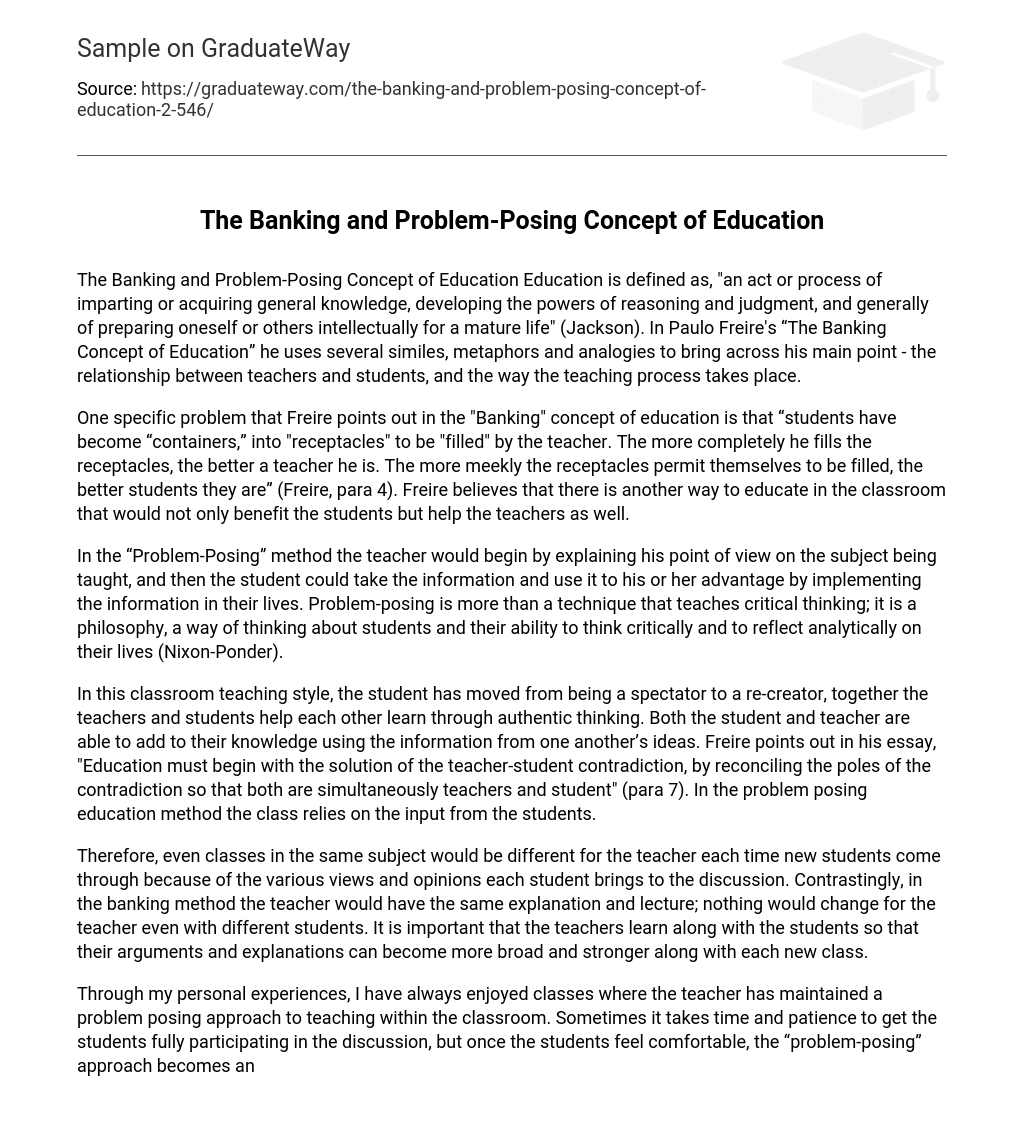Education is defined as, “an act or process of imparting or acquiring general knowledge, developing the powers of reasoning and judgment, and generally of preparing oneself or others intellectually for a mature life” (Jackson). In Paulo Freire’s “The Banking Concept of Education” he uses several similes, metaphors and analogies to bring across his main point – the relationship between teachers and students, and the way the teaching process takes place. One specific problem that Freire points out in the “Banking” concept of education is that “students have become “containers,” into “receptacles” to be “filled” by the teacher. The more completely he fills the receptacles, the better a teacher he is. The more meekly the receptacles permit themselves to be filled, the better students they are” (Freire, para 4). Freire believes that there is another way to educate in the classroom that would not only benefit the students but help the teachers as well.
In the “Problem-Posing” method the teacher would begin by explaining his point of view on the subject being taught, and then the student could take the information and use it to his or her advantage by implementing the information in their lives. Problem-posing is more than a technique that teaches critical thinking; it is a philosophy, a way of thinking about students and their ability to think critically and to reflect analytically on their lives (Nixon-Ponder).
In this classroom teaching style, the student has moved from being a spectator to a re-creator, together the teachers and students help each other learn through authentic thinking. Both the student and teacher are able to add to their knowledge using the information from one another’s ideas. Freire points out in his essay, “Education must begin with the solution of the teacher-student contradiction, by reconciling the poles of the contradiction so that both are simultaneously teachers and student” (para 7). In the problem posing education method the class relies on the input from the students.
Therefore, even classes in the same subject would be different for the teacher each time new students come through because of the various views and opinions each student brings to the discussion. Contrastingly, in the banking method the teacher would have the same explanation and lecture; nothing would change for the teacher even with different students. It is important that the teachers learn along with the students so that their arguments and explanations can become more broad and stronger along with each new class.
Through my personal experiences, I have always enjoyed classes where the teacher has maintained a problem posing approach to teaching within the classroom. Sometimes it takes time and patience to get the students fully participating in the discussion, but once the students feel comfortable, the “problem-posing” approach becomes an excellent learning environment. There are certain courses that would be easier to teach with the banking method of education, for instance on the first day of a chemistry class it would be tough for the students to jump right into discussion and make points on new and unfamiliar subject material.
A certain amount of knowledge is required before taking advanced courses, and the best way for students keep up with these courses would require some memorization from previous courses. Teachers and students may find that the best method is a combination between the extremes of the banking lecture, and the problem posing interrelationship comparing. Furthermore, teachers should not just teach, and the students should not just learn, but both teachers and students should go through the process of learning together, eliminating the gap of difference that exists between the two. Not only does this eliminate the boredom that often occurs in classrooms, but actually results in motivation for students to speak out sharing what they know, which further increases their knowledge.
Works Cited
- Freire, Paulo. The Banking Concept of Education, from Pedagogy of the Oppressed. Trans. Myra Bergman Ramos. New York: Continuum, 1993.
- Jackson, Shenith. “The Definition of Education. ” Helium. com. Helium Educational Philosophy, 2002. Web. 28 October 2011 Nixon-Ponder, Sarah.
- “Teacher to Teacher: Using Problem-Posing Dialogue in Adult Literacy Education. ” Kent. edu. Kent University, 2010. Web. 29 October 2011





